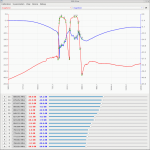When the MicroP25RX was first being developed, it was planned to add pre-select filters to various versions of the product for different frequency bands. Several people pointed out that 770 and 850 MHz bands have been combined for systems in larger cities due to shortage of spectrum. At the time, I stated that the approach could be to either combine multiple receivers with a single filter each or to implement RF-switched filter paths. Since then, I thought of another approach for a dual-pass-band filter. This is the BTT SELECT-78 filter. The cell phone downlinks on either side of the 700/800 bands are not completely rejected at the edges. There is a small overlap in the roll-off. As you can see from the close-in and wide view plots, the filter has very high stop-band rejection from 30 MHz to 4 GHz.
Features:
Housed in aluminum enclosure
USB Type-C power supply
Power Indicator LED
SMA female IN / OUT connectors
Can be used with any receiver RTL, AirSpy, BlueTail, etc.
Integrated, ultra-high OIP3 preamp prevents loss of sensitivity and overcomes insertion loss of the filters, couplers. The preamp is preceded by a band-pass pre-select filter.
I will have more information soon, but I wanted to introduce the filter and get the discussion started. Thank you to @goldmyne99, @freqseeker, and @ScannerDude244 for helping to test the first few units. A few minor changes were made. The final results are what is shown in the attached S11/S21 calibrated measurements. S-parameter measurements from 30-4000 MHz will be available on-request.



Features:
Housed in aluminum enclosure
USB Type-C power supply
Power Indicator LED
SMA female IN / OUT connectors
Can be used with any receiver RTL, AirSpy, BlueTail, etc.
Integrated, ultra-high OIP3 preamp prevents loss of sensitivity and overcomes insertion loss of the filters, couplers. The preamp is preceded by a band-pass pre-select filter.
I will have more information soon, but I wanted to introduce the filter and get the discussion started. Thank you to @goldmyne99, @freqseeker, and @ScannerDude244 for helping to test the first few units. A few minor changes were made. The final results are what is shown in the attached S11/S21 calibrated measurements. S-parameter measurements from 30-4000 MHz will be available on-request.






